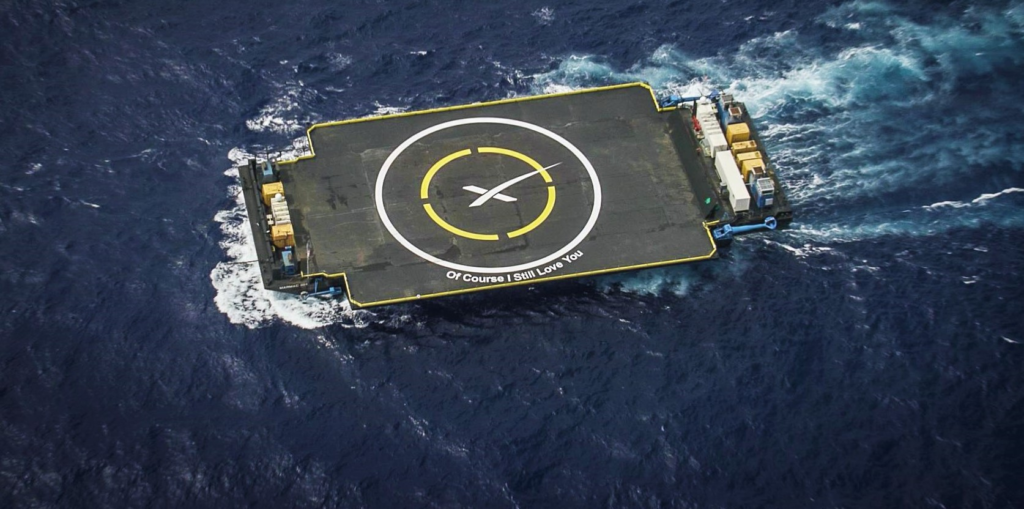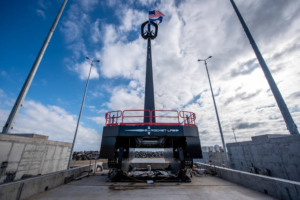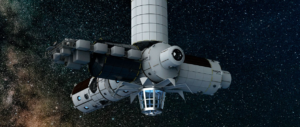
Blue Origin Is Planning To Use A Drone Ship To Land New Glenn
Blue Origin has been working on New Glenn for over a decade now after initial design work began in 2012. In the time since then, quite a lot has changed regarding not only the launch vehicle design but also its plans for reusability and schedule, just to name a few. One of the most drastic changes has to do with exactly how Blue Origin plans to land New Glenn’s massive booster.
Earlier this year we learned about this change when news came out that the ship Blue Origin had bought named Jacklyn, was scrapped. The original plan was to land New Glenn’s booster on a moving hydrodynamically stabilized ship that was converted into an advanced landing platform. However, based on different reports and contracts, it looks like the current plan will be a very large drone ship almost identical to what SpaceX uses for the Falcon 9 and Falcon Heavy boosters.
This being said, with the booster standing at just under 60 meters tall and 7 meters wide, this will be quite the feat for Blue Origin. Not to mention the fact that they are transitioning from New Shepard’s relatively small size to a heavy lift launch vehicle. Here I will go more in-depth into the company’s plan, the contractor for the job, what to expect in the future, and more.
Scrapped Ship

In 2018 Blue Origin bought a former roll-on/roll-off cargo ship to be transformed into New Glenn’s future sea landing platform. Over the next couple of years, up until 2022, the ship had been in port undergoing a refit to prepare for a novel role of landing launch vehicle first stages. The idea being, the rocket boosters were planned to be recovered downrange of the Cape Canaveral Launch Complex 36 (LC-36) in the Atlantic Ocean while the hydrodynamically-stabilized ship was underway. The ship stabilization technology was intended to increase the likelihood of successful rocket recovery in rough seas, as well as help to carry out launches on schedule. However, in August of this year, Blue Origin abandoned its plans to use the ship as a landing platform, and the ship was towed to the Port of Brownsville for scrapping.
As far as why the ship was scrapped and not turned back into a cargo ship, Clark Merritt, port director, highlighted that the process of converting the ship into a landing platform had gone too far to convert it back to a cargo vessel, but did not state why the conversion had stopped. As for Blue Origin’s reason, a company spokesperson said at the time, “Blue Origin is committed to safe and cost-effective access to space, and after careful consideration have made the decision to transition away from the Jacklyn as a landing solution.” While this is practically all that was said from Blue Origin about why the ship was scrapped, there are a few reasons we can infer. In reality, based on the project and the few comments from the company, the design likely became a big concern regarding cost, complexity, schedule, and even the use of humans on the vessel which was debated by the company. Specifically, Blue Origin had stated that the ship would not be crewed at the time the New Glenn booster was going to be landing; but rather would be autonomously or telerobotically controlled. All of which led to the decision to shift their focus to a drone ship just like SpaceX’s.
Drone Ship Contract

Even though Blue Origin’s landing ship was scrapped, New Glenn’s booster still plans to be reused 25 times and land out at sea each mission. This is why the company went searching for new options right after the decision to move on from the ship. Back in June of this year, Eric Berger tweeted saying, “It looks like Blue Origin will use the same contractor as SpaceX did to modify a large drone ship for landing its New Glenn rocket’s first stage. After moving on from the Jacklyn landing ship, it appears Blue Origin is pivoting to very Falcon 9-like operations.” This was in response to another tweet that went more in-depth into these future operations. Here the tweet mentioned, “LAD Services, Amelia, Louisiana has been selected by BLUE ORIGIN to build their new Autonomous Droneship Landing Platform, according to sources. Employees are expecting to build a nut and bolt copy of their previous SpaceX barges.”
Based on all this information it looks like Blue Origin has fully moved on from the ship option and has begun work on a drone ship. Comparing the size of SpaceX’s drone ships and the size of Falcon 9’s booster, we can try and get a better idea of what these future Blue Origin landing platforms will look like. Falcon 9’s booster is 3.7 meters wide and around 40 meters tall. The drone ships it lands on such as Just Read The Instructions for example is 170ft by 300ft or 52 meters by 91 meters. However, it’s important to point out that Falcon 9’s landing legs are very wide and feature a leg span of around 18 meters. This wide base helps stabilize the rocket during and after landing but also requires a bigger target in the process.
Looking at New Glenn, this booster is around 60 meters tall and almost double the diameter of the Falcon 9 with a 7 meter width. As for its legs, the aft module houses six hydraulically actuated legs that support and secure the first stage during landing. Compared to Falcon 9’s booster these legs are a lot closer to the stage and don’t go out nearly as far. With all things considered both boosters have a very similar footprint despite the size difference. As for Blue Origin’s future drone ships, it’s hard to say the dimensions and exactly what they will look like but we can expect a slightly bigger version than what SpaceX operates today.
Focusing on New Glenn’s mission profile also gives us a better idea. As we know, the reusable component of the New Glenn launch system is its first stage, including its seven BE-4 engines. During a mission, after second stage separation, the first stage booster reorients itself to reenter the atmosphere aft end first. Through a combination of aerodynamics and propulsive maneuvers, the stage performs a precision landing on the ocean-going platform in the Atlantic Ocean. After recovery at sea, the booster returns to the launch site via Port Canaveral for inspection and reuse. At the top of the stage are four fins. The four forward fins are actuated aerodynamic control surfaces used for attitude adjustment during descent and landing of the first stage. At the bottom, two wing-like strakes provide lift and cross-range for the reusable first stage as it flies back to Earth.
As for this launch vehicle’s progress, it still has quite a long way to go which gives the drone ship construction time to build. Currently, Blue Origin as a company is targeting 2024 for the first launch, however, a more realistic estimate would be later in 2025 as New Glenn still has a lot of work and testing necessary prior. On the bright side, its BE-4 engines are only months away from a vital first flight test on ULA’s Vulcan. An important step in the future of New Glenn’s operations.
While the company has quite a few challenges ahead of it, one of the most pressing is the shift toward New Glenn. This heavy-lift launch vehicle is extremely ambitious in almost every way. Even though ideas like this can help innovate, they can also cause immense delays and unsuccessful results. In Blue Origin’s case, they are going from New Shepard to New Glenn. To put it in perspective, New Shepard’s booster is around 17 meters tall and goes 100 kilometers high before coming back down to land. While impressive, the difference between this and what New Glenn is hoping to achieve can not be understated. New variables include increased speed, size, power, smaller landing platform, out at sea, and more. All of which the company will need to figure out in a relatively short period of time if they want to avoid additional delays.
Taking a closer look at the booster, all the engines combined will produce around (3,850,000 lbf) total thrust at sea level. The restartable BE-4 engines are hoping to provide precision thrust vector control and continuous deep throttle capability to support propulsive deceleration and landing maneuvers, while featuring long design life. The 8.5 m (28 ft) diameter engine skirt protects the engines from atmospheric reentry conditions and contains six stowed landing gear. The mid module of the booster houses the fuel (LNG) and oxidizer (LOX) tanks. The tanks are made of ortho grid aluminum and are designed to withstand the high g-loads realized during reentry. This section of the booster also provides ground umbilical connections for New Glenn and interstage housing of the two second stage vacuum-optimized BE-3U engines. The forward module houses various guidance navigation & control avionics, including an autonomous flight safety system. The pneumatic pusher stage separation system, which provides positive separation before second stage ignition, is located in the forward module. All of which makes up the first stage of New Glenn working to land at least 25 times on a drone ship in the coming years.
Conclusion
Blue Origin has its hands full with the New Glenn project. Between the launch vehicle itself, the BE-4 engines, the landing platform, and much more, there is a lot of work to do. Based on different updates and reports from the company, we are still a few years away from watching New Glenn lift off for the first time. We will have to wait and see how it progresses and the impact it has on the space industry.



